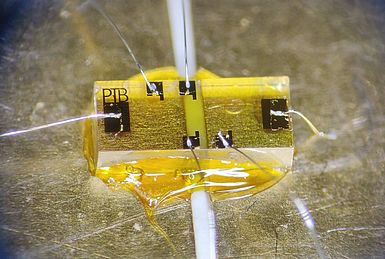Please type a search term (at least two characters)
News
Work of EMPIR project on graphene standard features in BIPM press release

Establishing SI linked quantum traceability by exploiting the potential of graphene
The project
EMPIR project Graphene impedance quantum standard (18SIB07, GIQS) is working to establish a new primary standard for impedance, linked to the revised SI Units, by exploiting the quantum effects of graphene. This is important because the marketability of electronic products relies on quantifications of voltage, resistance, and impedance.
Novel digital impedance measurement bridges developed in the project combined with a simpler cooling method have resulted in a graphene-based quantum Hall resistance device. This will enable a cheaper and easier-to-operate primary standard, and more affordable and improved measurement services. The project will also help link other electrical units to the revised SI units, while new devices will become possible in the technology sector, for faster, more sensitive measurement methods.
BIPM press release
The BIPM (Bureau International des Poids et Mesures) is the international organisation established by the Metre Convention, through which Member States act together on matters related to measurement science and measurement standards. It is also the home of the International System of Units (SI) and the international reference time scale (UTC).
BIPM has experimented with graphene quantum Hall devices developed within the EMPIR project with positive results, and has issued a press release entitled Preparing for the transition from a GaAs to a graphene-based quantum Hall resistance reference at the BIPM.
Some extracts from the press release:
- ‘The BIPM has recently had the opportunity to study a new graphene-based QHR sample developed by PTB, Germany’s National Metrology Institute, within the framework of the Graphene Impedance Quantum Standard (GIQS) EURAMET project’
- ‘Based on these encouraging results, the transition from the actual GaAs-based QHR reference to a compact graphene-based reference, allowing relaxed operational conditions, is now underway at the BIPM and is planned to be effective in a few years’ time. In the meantime, the study of other graphene-based samples from other sources and/or improved versions of the existing samples will continue, in particular regarding the stability of their carrier density over time or their ability to be easily tuned before use.’
Project Coordinator Klaus Pierz from PTB said
‘This really is a success for the GIQS project and all partners are very happy about the recognition by the BIPM. It was the first time that a graphene device was given away to a stakeholder for an external test. This good result underlines the stability of such resistance standards and the easiness of handling in a user lab’.
This EMPIR project is co-funded by the European Union's Horizon 2020 research and innovation programme and the EMPIR Participating States.
Want to hear more about EURAMET?
Sign up for EURAMET newsletters and other information
Follow us on LinkedIn and Twitter
Carbon dioxide, released from man-made activities, is lowering the pH of the Earth’s oceans, and impacting the health of marine organisms worldwide more
Supporting automated and reconfigurable manufacturing systems more
Working with external project Cool White to test and suggest improvements on the locally available white paints more
The project FutureEnergy has provided new calibration services for ultra-high voltages and a good practice guide on Lightning Impulse dividers more
For many of the 5000 photonics companies in Europe a precise knowledge of a material’s optical properties is vital for industrial competitiveness more





